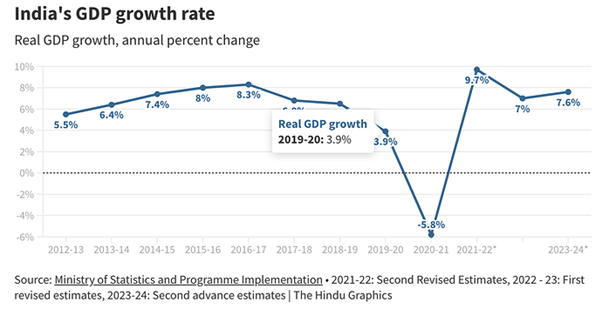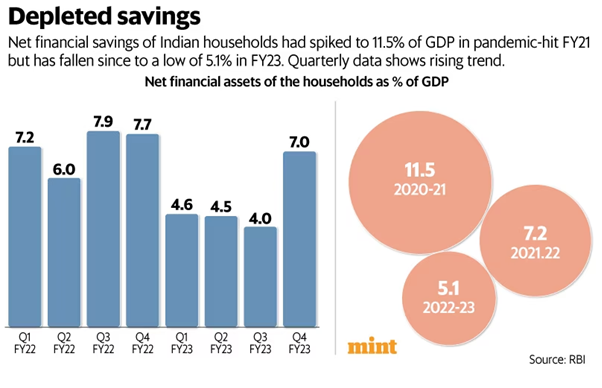INDIA’S GROWTH SURPRISE
Relevance: GS 3 – Indian Economy and issues relating to Planning, Mobilization of Resources, Growth, Development and Employment.
Why in the News?
- India’s GDP growth for the third quarter has exceeded expectations, reaching 6% according to the National Statistical Office’s second advance estimate.
- The initial estimate on January 5 projected GDP growth at 7.3%, indicating an upward revision.
- Additional data for two months has contributed to this growth, suggesting a strengthening economic momentum in the third quarter.
- Growth in gross value added, excluding the net tax impact, stood at 9%, indicating a slightly lower rate compared to the overall GDP growth.
Current Growth Scenario
- The full fiscal year’s growth projection stands at 7.6%, with the first three quarters averaging 8.2% growth.
- The implicit fourth-quarter growth is estimated at 5.9%, reflecting a slight moderation.
- Despite the pandemic’s impact, domestic strengths and policy measures have propelled the economy towards a 7% growth trajectory.
FACTORS INFLUENCING GROWTH
Strengthened bank and corporate balance sheets, along with government focus on infrastructure, have bolstered growth performance.
- The RBI’s latest monetary policy statement forecasted India’s GDP growth at 7% for the upcoming year.
- Growth is anticipated to moderate next year due to high interest rates and a lower fiscal impulse, with the fiscal deficit targeted to reduce to 5.1% of GDP.
- Monetary policy’s influence on economic growth is limited due to projected inflation levels staying above the RBI’s 4% target.
- Importance of Data Releases:
- The second advance estimates provide insights into GDP growth for the current year, although the provisional estimates in May are expected to offer a more accurate and long-lasting projection.
- Consumption Trends:
- Other accompanying data, such as details on private consumption, savings, and investment for 2022-23, add to the significance of the release.
- Private consumption growth at 3% has lagged behind overall GDP growth.
- Rural consumption likely trailed urban consumption due to higher food inflation impacting discretionary spending power, particularly with minimal growth in agriculture.
- Nominal food consumption spending saw a significant increase last year, likely continuing this trend, with certain sectors experiencing better performance for higher-ticket items compared to entry-level ones.
Trends in Consumption Expenditure
- Recent household consumption expenditure data indicates a shift towards non-food items over time, typically seen with rising per capita income.
- Even within food consumption, there’s a noticeable move from cereals towards processed items.
- This shift in consumption patterns could prompt adjustments in the weightages of the consumer price index basket, which currently reflects 2011-12 consumption patterns.
National Savings Dynamics
- The split of national savings among the government, households, and the private sector is a crucial data point.
- Despite remaining around 30% for 2022-23, the overall savings rate (savings/GDP) is below its decadal peak.
- Corporate savings represent 2% of GDP.
- Household Savings are divided into financial and physical savings.
- Household savings constitute the largest portion (61%) of total savings, with its share in GDP dropping to 4% in 2022-23.
- Financial savings data from the RBI, reported by NSO, indicates a notable decline in net financial savings of households, decreasing to 5.3% of GDP in 2022-23 from 7.3% in 2021-22.
- Net financial savings are calculated as the difference between gross savings and household borrowings/liabilities.
- While net financial savings as a percentage of GDP declined, there was a simultaneous increase in physical savings.
- Households seemingly utilized borrowings to acquire physical assets such as houses, consequently boosting physical savings.
Impact on Housing Demand
- Strong housing demand is evident, likely driven by increased retail borrowings amid robust asset demand.
- Consumers, especially younger demographics, are displaying a greater willingness to take on debt.
Shifts in Savings Dynamics
- Traditionally, savings in physical assets have outweighed those in financial assets.
- Financial inclusion initiatives have boosted the financial savings rate, narrowing the gap between financial and physical savings.
- However, during the pandemic, there was a notable increase in the financial savings rate while physical savings declined.
- In 2020-21, net financial savings briefly surpassed physical savings, but this trend corrected post-pandemic recovery.
- Household savings in physical assets have once again exceeded net financial savings, reaching a decadal low in 2022-23.
Disaggregated Investment Data
- NSO’s release includes comprehensive data on private corporate investments, alongside public and household investments for 2022-23.
- Public and household investments experienced faster growth in fiscal 2022-23, while private corporate investment stagnated.
- Similar trends are anticipated in the current fiscal, with government and household investments showing relative strength compared to private corporate investment.
SUSTAINING THE GROWTH FOR FUTURE
- Corporate Investment
- Current fiscal shows signs of a resurgence in corporate investments, particularly driven by the Production-Linked Incentive (PLI) scheme.
- Investments, especially in pharmaceuticals and electronics, have been notable under the PLI scheme.
- Rising investments in steel and cement are directly linked to government-led infrastructure and housing revival efforts.
- Investment Shifts
- Higher capacity utilization levels in the manufacturing sector are expected to translate into increased capital expenditure (capex).
- Transition from assembly-type operations to core/capital-intensive segments like advanced chemistry cell batteries and electric vehicles is foreseen under the PLI scheme.
- Healthy corporate balance sheets enhance the corporate sector’s capacity to leverage and undertake investments.
- A broad-based revival of private investments is deemed crucial for sustaining high growth rates in the medium term, especially as government investments moderate to facilitate fiscal consolidation.
- Policy Recommendations
- Reduction in policy uncertainty and compliance costs could provide an additional boost to corporate investments.
- Addressing these concerns would be a significant expectation from the next government, potentially providing further impetus to private sector investment.
Source: https://indianexpress.com/article/opinion/columns/dk-joshi-writes-indias-growth-surprise-9191094/
Mains question
Discuss the dynamics of India’s economic growth, focusing on shifts in savings patterns and the role of government policies. Evaluate challenges and recommendations for sustaining growth. (250 words)





